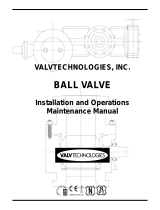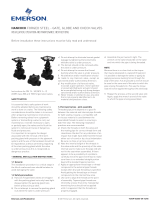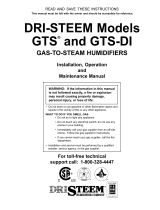
IM-P128-13 CMGT Issue 3
1
1. Safety information
2. General product information
3. Installation
4. Commissioning
5. Available spares and
maintenance
© Copyright 2018
Printed in GB
1280051/3
PC10HP
Pipeline Connector (ASME 600)
Installation and Maintenance Instructions
IM-P128-13
CMGT Issue 3

IM-P128-13 CMGT Issue 3
2
Safe operation of these products can only be guaranteed if they are properly installed,
commissioned, used and maintained by qualified personnel (see Section 1.12) in compliance
with the operating instructions. General installation and safety instructions for pipeline and plant
construction, as well as the proper use of tools and safety equipment must also be complied with.
1.1 Intended use
Referring to the Installation and Maintenance Instructions, product markings and Technical
Information Sheet, check that the product is suitable for the intended use/application. These
products comply with the requirements of the European Pressure Equipment Directive (PED) and
all fall within category 'SEP'.
It should be noted that products within this category are required by the Directive not to carry the
mark.
i) These products have been specifically designed for use on steam, air or condensate/water,
which is in Group 2 of the above mentioned Pressure Equipment Directive. The products
use on other fluids may be possible but, if this is contemplated, Spirax Sarco should be
contacted to confirm the suitability of the product for the application being considered.
ii) Check material suitability, pressure and temperature and their maximum and minimum values.
If the maximum operating limits of the product are lower than those of the system in which
it is being fitted, or if malfunction of the product could result in a dangerous overpressure
or overtemperature occurrence, ensure a safety device is included in the system to prevent
such over-limit situations.
iii) Determine the correct installation situation and direction of fluid flow.
iv) Spirax Sarco products are not intended to withstand external stresses that may be induced
by any system to which they are fitted. It is the responsibility of the installer to consider
these stresses and take adequate precautions to minimise them.
v) Remove protection covers from all connections and protective film from all name-plates,
where appropriate, before installation on steam or other high temperature applications.
1.2 Access
Ensure safe access and if necessary a safe working platform (suitably guarded) before attempting
to work on the product. Arrange suitable lifting gear if required.
1.3 Lighting
Ensure adequate lighting, particularly where detailed or intricate work is required.
1.4 Hazardous liquids or gases in the pipeline
Consider what is in the pipeline or what may have been in the pipeline at some previous time.
Consider: flammable materials, substances hazardous to health, extremes of temperature.
1.5 Hazardous environment around the product
Consider: explosion risk areas, lack of oxygen (e.g. tanks, pits), dangerous gases, extremes of
temperature, hot surfaces, fire hazard (e.g. during welding), excessive noise, moving machinery.
1. Safety information

IM-P128-13 CMGT Issue 3
3
1.6 The system
Consider the effect on the complete system of the work proposed. Will any proposed action (e.g.
closing isolation valves, electrical isolation) put any other part of the system or any personnel at
risk?
Dangers might include isolation of vents or protective devices or the rendering ineffective of
controls or alarms. Ensure isolation valves are opened and closed progressively to avoid system
shocks.
1.7 Pressure systems
Before attempting any maintenance of pipeline connectors, ensure that any pressure is isolated
and safely vented to atmospheric pressure before attempting any maintenance programme.
1.8 Temperature
Allow time for temperature to normalise after isolation to avoid the danger of burns and consider
whether protective clothing (including safety glasses) are required.
1.9 Tools and consumables
Before starting work ensure that you have the correct tools and/or consumables available. Use
only genuine Spirax Sarco replacement parts.
1.10 Protective clothing
Consider whether you and/or others in the vicinity require any protective clothing to protect against
the hazards of, for example, chemicals, high/low temperature, radiation, noise, falling objects, and
dangers to eyes and face.
1.11 Permits to work
All work must be carried out or be supervised by a suitably competent person.Installation and
operating personnel should be trained in the correct use of the product according to the Installation
and Maintenance Instructions.
Where a formal 'permit to work' system is in force it must be complied with. Where there is no such
system, it is recommended that a responsible person should know what work is going on and,
where necessary, arrange to have an assistant whose primary responsibility is safety.
Post 'warning notices' if necessary.
1.12 Handling
Manual handling of large and/or heavy products may present a risk of injury. Lifting, pushing,
pulling, carrying or supporting a load by bodily force can cause injury particularly to the back. You
are advised to assess the risks taking into account the task, the individual, the load and the working
environment and use the appropriate handling method depending on the circumstances of the work
being done.
1.13 Residual hazards
In normal use the external surface of the product may be very hot. If used at the maximum permitted
operating conditions the surface temperature may reach temperatures in excess of 425 °C (797 °F).
Many products are not self-draining. Take due care when dismantling or removing the product from
an installation (refer to 'Maintenance instructions').

IM-P128-13 CMGT Issue 3
4
1.14 Freezing
Provision must be made to protect products which are not self-draining against frost damage in
environments where they may be exposed to temperatures below freezing point.
1.15 Disposal
Unless otherwise stated in the Installation and Maintenance Instructions, this product is recyclable
and no ecological hazard is anticipated with its disposal providing due care is taken.
1.16 Returning products
Customers and stockists are reminded that under EC Health, Safety and Environment Law, when
returning products to Spirax Sarco they must provide information on any hazards and the
precautions to be taken due to contamination residues or mechanical damage which may present
a health, safety or environmental risk. This information must be provided in writing including Health
and Safety data sheets relating to any substances identified as hazardous or potentially hazardous.

IM-P128-13 CMGT Issue 3
5
2.1 Description
The PC10HP pipeline connector is designed
for use with the above listed swivel connector
steam traps up to the maximum pressure/
temperature limitations of the selected steam
trap. The connector can be fitted into any
vertical or horizontal pipeline and the trap can
also be rotated through 360º to ensure their
correct orientation for operation.
The principle is that the pipeline connector can be fitted into the pipeline without the trap fitted and the trap is
connected afterwards using just two bolts. The trap can be simply and quickly removed/replaced to minimise
system downtime and reduce maintenance resource.
Standards
These products fully comply with the requirements of the European Pressure Equipment Directive (PED).
Certification
This product is available with certification to EN 10204 3.1.
Note: All certification/inspection requirements must be stated at the time of order placement.
Note: For additional information see the following Technical Information sheet TI-P128-10.
2.2 Sizes and pipe connections
Condensate inlet/outlet DN15, DN20 and DN25
½", ¾" and 1" screwed BSP or NPT
Socket weld ends to ASME B 16.11/BS 3799 Class 3000.
Flanged versions are also available upon request. Please contact Spirax Sarco for further details.
The universal trap
gaskets are supplied
with the trap
Steam trap options:
-
UBP32
-
UTD30L
-
UTD30H
-
UTDS46M
-
UTD52L
-
UIB30
-
UIB45
-
UFT32
-
USM21 and
-
USM32
Fig. 1
The PC10HP has been designed for
use with the steam trap options listed
opposite.
2. General product information

IM-P128-13 CMGT Issue 3
6
ä
ä
A
2.3 K
v
values
Size DN15 DN20 DN25
For conversion:
C
v
(UK) = K
v
x 0.963
C
v
(US) = K
v
x 1.156
K
v
1.1 1.1 1.1
2.4 Dimensions/weights (approximate) in mm and kg
Size A Weight
½" 61.5 0.6
¾" 73.5 0.7
1" 90.0 0.7
2.5 Pressure/temperature limits (ISO 6552)
0 200 400 600 800 1000 1200 1400
0 20 40 60 80 99.3
425
300
200
100
0
700
600
500
400
300
200
100
Notes:
-
If flange connections are fitted then these will limit the maximum design conditions of the
pipeline connector.
-
The maximum operating limits of the complete assembly will be dictated by the steam trap
of choice. Reference the specific steam trap Technical Information sheet for its maximum
pressure / temperature limitations.
Body design conditions ASME Class 600
PMA Maximum allowable pressure 99.3 bar g @ 38 °C (1 440 psi g @ 100 °F)
TMA Maximum allowable temperature 425 °C @ 56 bar g (797 °F @ 812 psi g)
Minimum allowable temperature 0 °C (32 °F)
PMO
Maximum operating pressure for saturated steam
service
64 bar g @ 281 °C (928 psi g @ 538 °F)
TMO Maximum operating temperature 425 °C @ 56 bar g (797 °F @ 812 psi g)
Minimum operating temperature
Note: For lower operating temperatures consult Spirax Sarco
0 °C (32 °F)
PMOB Maximum operating backpressure should not exceed 80% of the upstream pressure
Designed for a maximum cold hydraulic test pressure of 149 bar g (2 161 psi g)
Temperature °C
Pressure bar g
Pressure psi g
Temperature °F
Steam
saturation
curve
The product
must not be
used in this
region.

IM-P128-13 CMGT Issue 3
7
3. Installation
Note: Before actioning any installation observe the 'Safety information' in Section 1.
There are a number of criteria which must be satisfied to ensure that the swivel connector trap will operate
correctly and ensure effective condensate removal. Referring to the Installation and Maintenance Instructions,
product markings and Technical Information Sheet, check that the product is suitable for the intended
installation:
3.1
Check materials and maximum pressure/temperature values. If the maximum operating limit of the
product is lower than that of the system in which it is being fitted, ensure that a safety device is
included in the system to prevent overpressurisation.
3.2
The correct steam trap and end connection must be selected to meet the system design conditions.
3.3
Steam trap connector bolts are supplied with the selected steam trap.
3.4
The joint between the PC10HP and trap is sealed with high integrity spirally wound gaskets.
During installation the gasket faces must be protected from damage caused by weld splatter, knocks,
etc.. to the trap gasket face. Hence care must be taken when installing the PC10HP into the pipework.
It is recommended that the trap is installed immediately the PC10HP is in the pipework. Alternatively,
the trap can be joined to the PC10HP prior to installation.
3.5
Determine the correct installation situation and direction of fluid flow. The PC10HP must be installed
with flow in the direction of the arrow. Flow can be horizontal (either direction), vertical or inclined.
The flow direction is clearly marked on the trap body or pipeline connector.
Caution: The connection face for the swivel connector steam trap of choice must always be in the
vertical plane unless stated on the product specific steam trap Installation and Maintenance
Instructions provided with the product.
3.6
Remove protection covers from all connections, where appropriate, before installation on steam or
other high temperature applications.
3.7
Suitable isolation valves must be installed to allow for safe maintenance and trap replacement.
Where the trap discharges into a closed return system a non-return valve should be fitted downstream
to prevent back flow.
3.8
Always open isolation valves slowly until normal operating conditions are achieved – this will avoid
system shocks. Check for leaks and correct operation.
3.9
Always ensure the correct tools, safety procedures and protective equipment are used at all times.
3.10
When a socket weld version is being installed the welding should be carried out to an approved
procedure of a recognised standard.
3.11
Welding into pipeline of socket weld variants
A universal weld procedure covering the requirements of different National and International
Standards and practices is difficult to provide - specifically regarding the welding procedure, welding
conditions (run number, consumable size, current, voltage, polarity), storage of consumables and
make/type of consumables due to the abundance of appropriate consumable suppliers.
Welding advice based on British Standards can be provided, contact Spirax Sarco to discuss
your welding requirements further. Welding can be carried out to ASME IX or BS EN standards
as applicable.
Important Notes:
1. If the trap is to discharge to atmosphere, ensure that it is to a safe place. The discharging fluid
may be at a temperature of 100 °C (212 °F).
2. After installation it is recommended that the PC10HP pipeline connector is insulated to minimise
radiated heat losses and to protect personnel from burns risk. Please note that there are some trap
types that should not be insulated.

IM-P128-13 CMGT Issue 3
8
4. Commissioning
5. Available spares and maintenance
Please note that there are no spare parts for the PC10HP pipeline connector.
If spare parts are required for the steam trap that is connected to the PC10HP we recommend that you use
the product specific Installation and Maintenance instructions for that particular product.
After installation and maintenance ensure that the system is fully functional. Carry out tests on any alarms
or protective devices.
-
 1
1
-
 2
2
-
 3
3
-
 4
4
-
 5
5
-
 6
6
-
 7
7
-
 8
8
Spirax Sarco 67988 Installation guide
- Type
- Installation guide
- This manual is also suitable for
Ask a question and I''ll find the answer in the document
Finding information in a document is now easier with AI
Related papers
-
Spirax Sarco 1842752 Installation guide
-
Spirax Sarco Drip Pan Elbow Installation And Maintenance Instructions
-
Spirax Sarco IPC 20 and IPC 21 Pipeline Connectors Installation guide
-
Spirax Sarco 65640380 Installation guide
-
Spirax Sarco SDCV44 Split Disc Check Valves Installation And Maintenance Instructions
-
Spirax Sarco 6235102 Operating instructions
-
Spirax Sarco DP143, DP143G, DP143H Installation And Maintenance Instructions
-
Spirax Sarco 68600 Installation guide
-
Spirax Sarco 2103097 Installation guide
-
Spirax Sarco 62771 Installation guide
Other documents
-
Watts Steam Products Guide
-
Watts Steam User guide
-
Yarway Series 711, 731, 746 and 751-F2 Unibody Plus Steam Traps Owner's manual
-
 ValvTechnologies V1 Series Installation And Operations Maintenance Manual
ValvTechnologies V1 Series Installation And Operations Maintenance Manual
-
Hubbell STH User manual
-
Johnson Controls Penn P28 Series User manual
-
Vaisala PR-43-GC User manual
-
KROHNE OPTISWIRL 4070 Quick start guide
-
 Hancock Forged Steel Gate, Globe and Check Valves IOM Owner's manual
Hancock Forged Steel Gate, Globe and Check Valves IOM Owner's manual
-
 DriSteem GTS Installation, Operation and Maintenance Manual
DriSteem GTS Installation, Operation and Maintenance Manual










